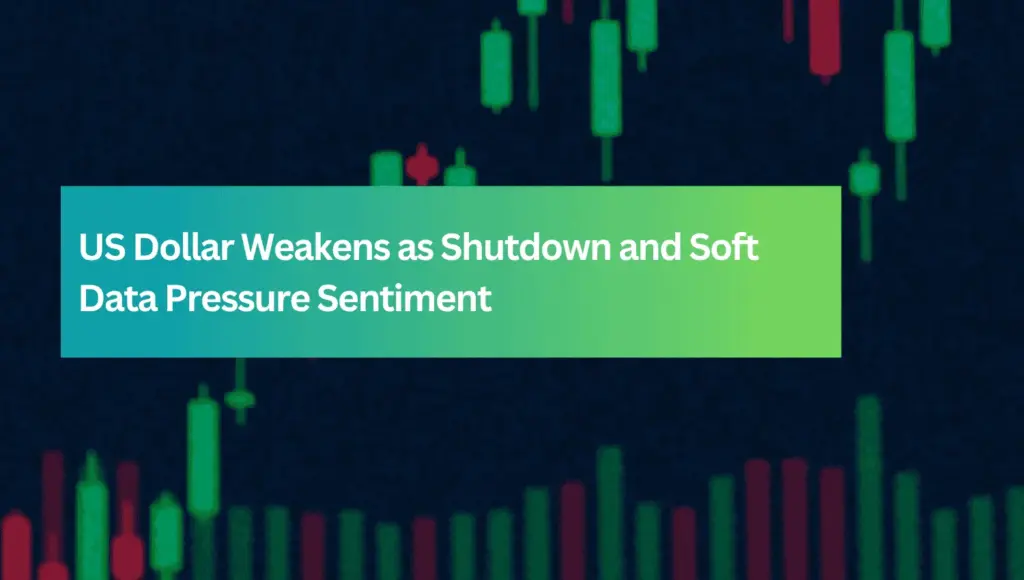News

The U.S. dollar advanced for a third time in four sessions on Tuesday, buoyed by persistent global instability and risk aversion. Investors viewed the greenback as the “cleanest dirty shirt,” strengthening not from domestic optimism but from weakness in the euro and yen. Political turmoil in France deepened as markets questioned President Emmanuel Macron’s authority, while concerns about Japan’s fiscal discipline following its leadership transition weighed on the yen. Despite the U.S. government shutdown entering its second week, the dollar index rose 0.48%, extending its post-September recovery. Fed Commentary and Consumer Outlook Mixed With official data frozen by the shutdown, focus turned to Federal Reserve speakers for guidance. Governor Stephen Miran warned that policy remains restrictive but noted earlier uncertainties have eased. In contrast, Minneapolis Fed’s Neel Kashkari cautioned that aggressive rate cuts could reignite inflation, while Vice Chair Philip Jefferson flagged the risk of job market stress if monetary support fades. Meanwhile, the New York Fed’s consumer survey revealed greater pessimism about employment and rising one-year inflation expectations at 3.4%, painting a mixed picture ahead of next week’s inflation releases. Market Reaction and Asset Moves Bond markets reflected cautious optimism. Treasury yields slipped slightly, led by strong demand at a three-year note auction, flattening the 2s–10s curve. U.S. equities weakened, with the S&P 500 down 0.41%, as investors consolidated near record highs. Commodities were volatile: WTI crude rose 0.31% but stayed near multi-month lows, copper climbed 1.16% on supply concerns, and gold gained 0.56% after futures briefly topped $4,000 per ounce, highlighting sustained safe-haven demand. FX: Euro, Yen, and Pound Slide Currency markets showed broad dollar strength. EUR/USD fell 0.44% as France’s political instability pressured the euro, while GBP/USD lost 0.40% amid soft U.K. data and cautious BoE expectations. The yen was the weakest performer, with USD/JPY surging 1.01% beyond 150 as fiscal concerns overshadowed the BOJ’s steady stance. Commodity currencies underperformed too—AUD/USD dropped 0.49% on fading risk appetite. Outlook Tuesday’s session underscored a fragile global backdrop where investors continue to favor the dollar as a relative safe haven. With the U.S. shutdown unresolved and key data delayed, focus now shifts to upcoming Fed communications and global political developments, which are likely to dictate near-term currency and risk sentiment.

The U.S. dollar slipped on Friday, extending its weekly losses as disappointing U.S. data reignited concerns about slowing growth while the government shutdown delayed the release of key indicators, including the all-important nonfarm payrolls. The ISM non-manufacturing PMI fell sharply to 50.0 in September, barely signaling expansion and missing expectations. The weaker reading overshadowed a modest uptick in the S&P Global services PMI, reflecting mixed signals for the broader economy. The data vacuum caused by the shutdown made it harder for markets—and the Fed—to gauge underlying momentum, reinforcing bets on rate cuts before year-end. Fed Speeches Highlight Policy Divide Federal Reserve officials delivered contrasting remarks that deepened market uncertainty. Dallas Fed’s Lorie Logan reiterated that inflation remains elevated but described policy as only “modestly restrictive,” while Vice Chair Philip Jefferson warned that the labor market could weaken without continued monetary support. By contrast, Governor Stephen Miran said current rates are already “too high,” calling for a faster pivot toward easing. This divergence underscored the Fed’s growing internal split and fueled speculation that the pace of rate cuts will depend heavily on upcoming data once released. Currencies and Market Moves The dollar’s retreat was most pronounced against European currencies. EUR/USD climbed toward 1.1740, bolstered by firmer eurozone inflation expectations that backed the ECB’s cautious stance. GBP/USD advanced to 1.35 amid optimism that U.K. inflation has peaked, giving the Bank of England flexibility to adjust policy. Meanwhile, USD/JPY edged higher despite broad dollar softness, with Japan’s upcoming LDP leadership vote viewed as a key influence on BOJ policy direction. The AUD/USD rose modestly, aided by strong metals performance as gold and copper extended gains. Bonds, Equities, and Commodities U.S. Treasury yields rose slightly, with a mild steepening of the 2s–10s curve (+2bps to +53.8bps). Equities were resilient, with the S&P 500 finishing up 0.13%, led by tech and consumer discretionary names. In commodities, WTI crude rebounded 0.55% after a 7% weekly drop, gold gained 0.74% on safe-haven demand, and copper jumped 2.84% on supply concerns. The dollar index fell 0.12%, ending a volatile week marked by mixed data and shutdown-induced uncertainty. Summary:Friday’s session captured a fragile balance between weak data, divided Fed rhetoric, and resilient risk appetite. With the shutdown curbing data visibility, markets now await clarity from Washington and a return of economic releases to confirm whether U.S. growth is truly faltering—or simply pausing.
